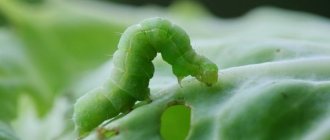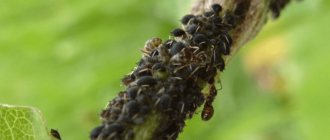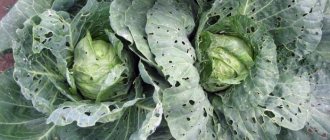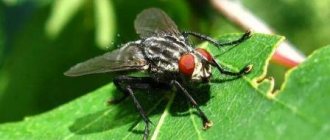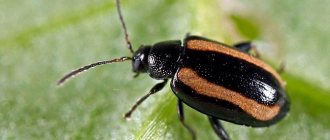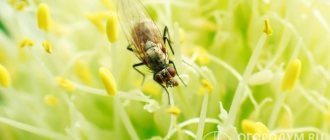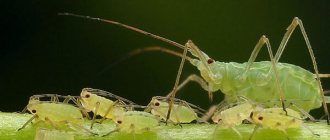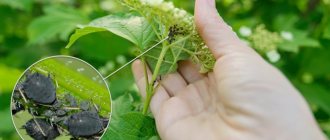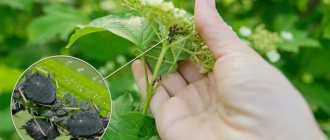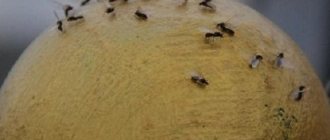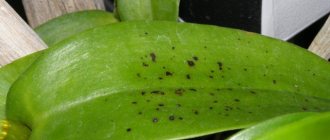Cabbage is affected by many pests, among them there are small ones, which are popularly called midges. In fact, we are not talking about one species, but about different insects that feed on the sap of plant leaves. Many gardeners do not know how to treat cabbage against midges, cruciferous flea beetles and aphids. There are several ways to combat them, but before you move on to studying them, you need to take a closer look at the small insects that attack cabbage beds.
Midge on cabbage
What kind of insect is this
The cruciferous flea beetle is a small leaf beetle (body length - from 2.0 to 3.5 millimeters), characterized by a varied body color (from black with a characteristic tint to two-colored) and having powerful hind jumping legs. It feeds exclusively on weeds and cultivated plants of the cruciferous family, causing great damage to the latter.
On a note. You can distinguish a flea beetle from other small beetles by the characteristic large jumps it makes, accompanied by characteristic clicks.
Prevention of appearance before and after sowing
To protect and prevent the appearance of midges on cabbage seedlings, you should follow several rules. How to protect and preserve plants:
- Plant cabbage seedlings as early as possible. In this case, plants should be protected from the cold by covering them with spunbond, agrospan or lutrasil. At the same time, the dense material will prevent the appearance of pests.
- Provide cabbage with regular watering. Midges cannot tolerate high humidity.
- Regularly apply mineral fertilizers containing potassium and phosphorus. Microelements increase plant resistance to pest attack.
- Clear rows of organic debris and weed. Insects overwinter and breed in plant debris and weeds.
- After harvesting, you should dig up the ground. Tilling the soil will help destroy midge larvae in the upper layers of the soil.
- Before planting seedlings, it is recommended to place onions or garlic in the neighborhood. Scented plants are something that can repel insects.
You can plant other seedlings next to the cabbage that will repel midges with their smell. These include:
- spices;
- potato;
- tomatoes;
- marigold.
Midges on cabbage multiply quickly, so a large colony can destroy an entire vegetable crop in 1-2 weeks and move to other garden plants. Both larvae and adults eat and drink juice from the vegetable crop. Cabbage can be affected by aphids, thrips, whiteflies and flea beetles. Each insect damages leaves differently.
What midges parasitize cabbage?
The following types of flea beetles parasitize cabbage:
- Black beetles are small beetles with black or dark blue elytra with a metallic tint.
- Light-footed (white) are fairly large (up to 3.5 millimeters in length) beetles with paws (legs) colored yellow.
- Wavy and notched - unlike previous species, these flea beetles have single, clearly visible longitudinal stripes of greenish or yellow color on each of the elytra.
Among these types of pests, the most common are wavy and black flea beetles.
Safety rules when working with ammonia
No matter how harmless a substance is, it can still cause unpleasant consequences. In the case of ammonia, the pungent and unpleasant odor that affects the human body is dangerous. If there is an excess of it, headaches, increased blood pressure, respiratory arrest, vomiting or irritation may occur; if it comes into contact with the skin, it may cause burns and redness.
It is recommended to carry out all manipulations with the substance in a well-ventilated room or in the fresh air, and when processing cabbage, wear protective clothing that covers the body as much as possible, gloves and a respirator (at least a gauze bandage).
Attention! Ammonia must not be mixed with chlorine-containing substances.
Signs of damage to cabbage beds
The main signs of damage to a cabbage plot by the cruciferous flea beetle are the following:
- holey eating of young leaves of cabbage seedlings;
- wilting and drying of leaves.
Another sign of cabbage being damaged by this pest is the presence on the leaves and soil around the plants of a large number of small insects that make large jumps.
Cabbage fly and its larvae (photo of what they look like)
The pest comes in two varieties: spring and summer cabbage fly. Outwardly, they are not much different from each other, and this is of no use to a simple gardener. It is more important for him to know some of the nuances of their development in order to apply this knowledge in the fight against it.
The pest overwinters in the soil in the pupal stage. Their mass emergence coincides with the flowering of cherry, birch and lilac. Immediately after leaving the winter, the insect feeds on weeds for several days and then flies to the planted seedlings. Soon after hatching, the adults mate. And after 8-10 days, the female lays white eggs, 2-3 pieces each, on the lower part of the plant or at the base of the neck of the trunk on the ground. One female can lay up to 100 eggs in her life.
Observations have established that eggs can be laid by different females under one plant. The fly lays eggs under more developed plants and very rarely under seedlings with fewer than three leaves. Lack of moisture slows down the development of eggs and even destroys them en masse.
What does the pest look like? Look at the photo. The male has three longitudinal dark brown stripes clearly visible on the back and one on the abdomen.
Male cabbage fly
The female is light gray in color, the stripes on her back are barely noticeable.
Female cabbage fly
Egg laying begins 4-6 days after the bird cherry blossoms and begins at a temperature of +10+12ºС. Females prefer lumpy, coarse-grained soil and avoid sprayed soil. The eggs are 1-1.1 mm in size, white, elongated, cigar-shaped. One end, blunt with a deep groove, widened towards a blunt end.
After 3-5 and up to 10 days, legless larvae, the so-called white root worms up to 8 mm long, begin to hatch from the eggs. They go deep into the soil and penetrate into the root or lower part of the stem of the seedling. The larvae, depending on the air temperature, live up to 20-30 days. They molt three times and then turn into pupae - a false cocoon. The development of the pupa lasts 10-20 days, after which the second generation of the pest emerges. The second generation larvae appear in early July and, as a rule, they are no longer dangerous to the cabbage itself.
In the northern and central zones of Russia, the spring fly pest develops in two generations, in the south - in three.
Signs of plant damage by cabbage fly
How do you know if cabbage is infected with cabbage fly larvae? Larvae - worms, penetrating into the stem of a plant, eat away the winding passages in them. The plant begins to hurt, wither, and look as if they are not getting enough water. However, even with established watering, nothing changes. The damaged plant lags behind in growth and withers in the heat. The leaves take on a purple hue. Damaged roots become entry points for the penetration of pathogenic bacteria and fungi, so the roots begin to rot.
The first sign of the presence of larvae in the root of a plant is stunted growth and wilting of the leaves.
In addition, the larvae damage the internal part of the root and disrupt the supply of nutrients to the above-ground part of the plant. This leads to weakening and death of the cabbage.
The first generation larvae are the most harmful. The second generation is not so dangerous, since the plant is already strong by this time.
Why are they dangerous?
The danger of these pests lies in the following negative effects on crop plants:
- in severe damage to leaf blades, leading to their withering and drying out;
- reducing the leaf area involved in photosynthesis, which significantly reduces the accumulation of nutrients in heads of cabbage;
- reduction in the yield and quality of cabbage heads;
- complete destruction of seedlings and death of the entire plantation.
Settling on the cabbage seeds, flea beetles damage the leaves and cause a decrease in the yield and quality of the seeds.
On a note. Contrary to misconception, flea beetles do not cause serious damage to the root system - their larvae developing in the soil eat the roots, but do not cause significant damage to the plants.
general characteristics
Ammonia (chemical formula NH3) is a colorless gas that, when combined with water, forms a new substance known as ammonia (NH4OH). It is a universal fertilizer that is suitable for spraying most garden and vegetable crops. The drug can be purchased at pharmacies and stores specializing in gardening tools. Many vegetable growers are puzzled by the question of whether cabbage should be treated with ammonia?
Professionals say there are benefits to this. Ammonia for cabbage is an excellent development aid. Ammonia protects against pests and helps restore previously fertile soils.
Pest Control
Watering cabbage with ammonia helps get rid of pests such as:
- aphid;
- secretive proboscis;
- ants;
- mole crickets;
- whitefish;
- slugs;
- midges.
The volatile compounds contained in the drug dissipate quite quickly. It is this smell that guarantees complete removal of insects.
Ammonia as a fertilizer
Nitrogen is an essential component for plant growth. It is part of chlorophyll, lipoids and plant organelles.
The absorption of nitrogen by plants occurs exclusively through various chemical compounds from the soil. Therefore, the process of assimilation is quite complex. Plants may experience some problems with development: the formation of ovaries slows down, the leaves lose color and become fragile. As soon as these problems appear, you need to treat the young cabbage with ammonia.
It is interesting that nitrogen is absorbed much easier and faster in the composition of ammonia than in standard organic complex fertilizers. And most importantly, the price of the medicine is much lower than garden fertilizers.
Folk methods of struggle: all the pros and cons
The main advantages of folk remedies against fleas on cabbage are the following:
- ease of preparation;
- availability;
- cheapness;
- environmental friendliness.
The main disadvantage of such products is their low effectiveness when there are large numbers of pests on the affected plants.
When is it better to treat with folk remedies, and when with chemicals?
Folk recipes consist of natural ingredients.
Plant elements, food, washing liquids - the composition of home protective products includes any available materials. Ready-made solutions do not contain toxic, poisonous or poisonous elements. They can be used at any stage of the growing season: from seedlings to harvesting. Traditional recipes will be effective for routine preventive treatment of cabbage and for combating a small number of garden pests on small acreage. If the colony of parasites grows, the condition of the cabbage worsens, insecticides come to the rescue - chemicals to destroy harmful organisms. Modern means are destructive for adult parasites, eggs and larvae.
Important!
The use of chemicals has a number of restrictions. Preparations with an aggressive composition are not used for ripened cabbage. The last permitted treatment period is 30 days before cutting the heads of cabbage.
What do people use?
As folk remedies, decoctions and infusions of various plants, tobacco dust, wood (stove) ash, solutions of ammonia, valerian, and iodine are used.
See also
How to properly plant cabbage in open ground with seedlings, distance, timing and temperature
Read
Ammonia solution
20-25 milliliters of an alcohol solution of ammonia (40-45 drops) are diluted with 10-12 liters of rainwater, poured into a watering can and the leaves of plants affected by the pest and the soil around them are watered with the resulting solution. When working with such a folk remedy, you cannot use sprayers and atomizers - when spraying plants with them, the ammonia contained in the solution will evaporate very quickly, and the treatment will have low efficiency.
Potato broth
This product is prepared as follows:
- 4-4.5 kilograms of chopped green and healthy potato tops are placed in an enamel bucket.
- The tops are poured with 10 liters of water, put on fire and, bringing to a boil, cook for 15-20 minutes.
- The hot broth is allowed to cool for some time to room temperature, after which it is diluted in a 1:1 ratio with cold water.
Cabbage plantations affected by flea beetles are sprayed with a diluted decoction.
Tobacco dust and wood ash
Wood stove or fireplace ash is mixed with tobacco dust in a 2:1 ratio. The resulting powder should be used to dust the flea-affected leaves and also sprinkle the entire soil around the plants.
The amount of such a dry mixture is calculated taking into account that 1 head of cabbage requires, on average, 200-250 milliliters of powder.
Celandine
Celandine leaves collected in the flowering and budding phase are dried in the shade, crushed by hand or using a coffee grinder. The resulting powder is used to dust the leaves and soil around the plants. The consumption rate of crushed celandine per plant is 10-15 grams. For better adhesion of the powder, the leaves of the plant should be sprayed with a soap solution in advance.
Celery stalk decoction
4 kilograms of celery green stalks are crushed, poured with 10 liters of water, put on fire and, bringing to a boil, boil for 0.5 hours. Then the broth is given 3 hours to cool and brew, filter and dilute with clean water in a ratio of 1:5.
Before pouring the resulting decoction over the affected plants, add a small amount of liquid soap (40-45 grams).
Red pepper
One medium-sized pepper is passed through a meat grinder, poured with 1 liter of water and allowed to brew for 3-3.5 hours. Before spraying the affected plants, filter the infusion through gauze or a sieve and add 5-10 grams of liquid soap to it.
Needles
To rid the garden of a small number of fleas, 10-15 drops of essential fir oil are diluted in 10 liters of water, after which the resulting solution is sprayed on the affected plants and the soil around them.
Hot pepper infusion
100 grams of hot pepper pods are crushed using a meat grinder or blender, poured with 1 liter of warm water and allowed to brew in a warm, dark place for about 48 hours. Then the infusion is filtered and diluted with clean water in a ratio of 1:100 (100 grams of infusion is diluted in 10 liters of clean water). It is recommended to spray the leaves and soil around the plants with the resulting product in the evening and morning hours.
Chicken droppings
This effective anti-flea flea remedy and nutritious organic fertilizer are prepared as follows:
- A 100-liter barrel is filled to 1/3 of its volume with chicken droppings;
- the barrel is filled to the top with water;
- Using a stick, the litter is mixed with water and allowed to brew for several days;
- the finished concentrate is diluted with clean water in a ratio of 1:10.
The resulting fertilizer is used to water the soil around the plants - the solution not only helps eliminate the deficiency of macro- and micronutrients during critical phases of crop growth, but also repels pests with its smell.
See also
Growing and caring for Chinese cabbage in open ground and greenhouse
Read
Garlic
200 milliliters of garlic cloves and chopped fresh tomato tops are passed through a manual or electric meat grinder, the resulting pulp is poured with 10 liters of water and left for about 2 hours. The resulting infusion is sprayed not only on the leaves, but also on the soil around the plants.
Dandelion
0.5 kilograms of freshly picked dandelion leaves, stems and roots are ground in a meat grinder, poured with 10 liters of warm, settled water and allowed to brew for 2 hours. Then the infusion is filtered, 3 tablespoons of liquid soap are added to it and the affected cabbage plantation is sprayed with it.
Tansy
You can effectively combat this pest using powder from dried and crushed tansy inflorescences. The consumption of such powder when dusting one plant and the soil around it is 10-15 grams.
Vinegar solution
Simple vinegar or its essence will help save plantings attacked by the pest. To do this, 200 milliliters of simple 9% vinegar or 25 grams of its 70% essence are poured into 10 liters of water, after which the plants are immediately sprayed with the resulting solution.
Chamomile infusion
1 kilogram of dry raw materials is placed in a large container, filled with 10 liters of hot water and allowed to brew for 24 hours. Then the infusion is filtered, diluted with water in a ratio of 1:3 and 40-45 grams of liquid soap are added.
Naphthalene with sand or ash
Naphthalene powder is mixed with fine-grained river sand or wood ash in a ratio of 1:5. The resulting mixture is sprinkled on the soil around the plants within a radius of 5 centimeters.
Infusion of common yarrow
800 grams of yarrow herb are placed in a large container, poured with 2 liters of boiling water, and then allowed to brew for 25-30 minutes. Then the resulting concentrate is filtered, poured into a 12-liter bucket and diluted to full volume with warm water. Before spraying the affected plants, the diluted infusion is kept in a warm room for 4 days.
Milk solution with iodine
Add 8-10 drops of iodine to 0.5 liters of milk with a fat content of 1.5%, stir thoroughly and immediately spray the plants affected by the pest with the resulting mixture.
Valerian solution
50 milliliters of valerian tincture is diluted in 3 liters of water. The solution is used immediately after preparation to spray plant leaves affected by the pest.
From cruciferous flea beetle
If a cruciferous flea beetle has attacked the crop, ammonia will help exterminate the pest. The insect cannot tolerate the pungent odor and immediately leaves the captured area. The processing does not have negative consequences for the vegetable itself; the quality of the heads of cabbage is preserved along with its taste characteristics. Prepare a solution according to the following recipe:
- 30 ml of ammonia;
- 100 ml of any liquid soap;
- a bucket of water.
Dilute all ingredients until the liquid becomes homogeneous, pour into a sprinkler and spray the vegetables from top to bottom. If a little solution remains after processing, then you can water the soil in the garden bed with it. This will be an additional measure of protection, since the pest can move along the ground.
Attention! Treatment with ammonia must be carried out very quickly, immediately after preparing the liquid. The main substance evaporates, and over time its concentration in the solution decreases, which makes the product insufficiently effective against insects.
Timing and technology of planting processing
There are the following methods for treating plants affected by flea beetles:
- Dusting is the application of finely ground powder from plant materials to pest-infested leaves and the soil around plants.
- Spraying - applying a solution of one of the folk remedies described above in the form of small drops to the leaves.
- Watering is treating the soil against pests by adding a liquid insecticide to it.
Dusting is carried out at any time of the day, in the absence of wind. Watering and spraying is carried out in the evening or in the morning, with complete calm, no dew on the leaves, and an air temperature of no more than +21 C.
Chemicals
Chemicals are used very rarely in private households, as gardeners understand how harmful they are. If midges and bugs have attacked cabbage beds and continue to multiply, no matter what, you will have to save the plants in radical ways, with the help of chemistry.
Attention! Insecticides can be used freely in the first half of the growing season. It is important to have time to carry out the last processing of cabbage a month before the start of harvesting. Otherwise, the toxic substances will not have time to be neutralized and will remain in the vegetables.
The following drugs will help quickly destroy midges:
- Aktara;
- Storm;
- Spark;
- Decis pro;
- Karate;
- Confidor;
- Aktellik;
- Intavir.
Intavir
Cabbage is processed with a freshly prepared solution in calm, dry weather. Before the procedure, wear a protective suit, mask and gloves so that chemicals cannot get on the skin and mucous membranes.
Attention! The spray tip is directed so that the product penetrates the underside of the leaf blades, where the pests lay eggs. This is where aphids and whitefly larvae hide.
A single treatment of cabbage against midges is not enough. The procedure is carried out 2-3 times per season with an interval of 2-3 weeks.
General description of the pest
Black midges harm many types of crops besides cabbage. So, the following are under attack: radish, daikon, radish, horseradish. Midge eggs survive the winter cold well in the ground, and with the first rays of ultraviolet light in the spring they come out. The first thing pests eat after winter is organic matter. Grown-up insects experience even greater hunger, so they begin to eat seedlings and cabbage turns out to be their preferred choice.
First, the midge eats the upper shell of the leaf. Young plants are of primary interest to her, as they are softer and juicier. Affected heads of cabbage stop actively developing, becoming susceptible to diseases and other parasites.
Preparatory activities
If bugs or flies appear in the seedlings, it is necessary to get rid of them urgently. Any delay threatens that there will be even more of them. It is necessary to use ready-made chemicals to kill pests and folk remedies.
It is necessary to dry the soil and remove excess moisture. To do this, the pots are placed in the sun and not watered for several days.
The room needs to be thoroughly cleaned, the floor, trash can, and window sills should be washed. All organic residues are removed from surfaces.
If the pots with seedlings are equipped with a tray for collecting water, it must be emptied and dried in a timely manner.
Between waterings, you need to loosen the soil - this will improve drying and provide air access to the root system.
Moderately dry soil allows:
- prevent rotting of the roots;
- prevent egg laying;
- deprive the larvae of food, as they feed on rotten roots.
In order to determine the degree of infection, you need to carefully remove the seedling from the pot and clean off the earthen lump. Afterwards the roots are inspected. If they are not covered with balls of worms, everything is not so scary.
